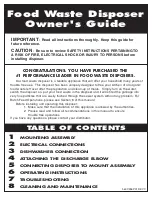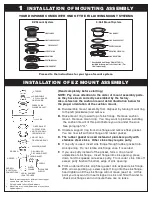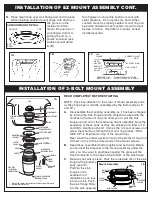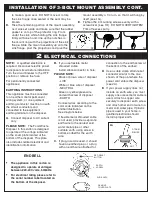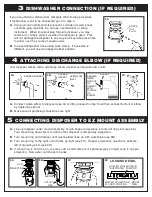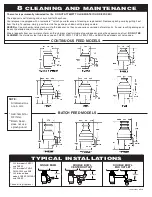
THIS DISPOSER UTILIZES ANTI-JAM SWIVEL IMPELLERS THAT MAKE A CLICKING SOUND AS THEY
SWING INTO PLACE. THIS INDICATES NORMAL OPERATION.
BATCH FEED MODELS:
LARGE
SMALL
MEDIUM
6
OPERATING INSTRUCTIONS
6A
6B
6C
6D
CONNECTING DISPOSER TO 3-BOLT MOUNT ASSEMBLY
A.
Remove sink stopper. Turn on
cold water using a medium flow.
B.
Turn switch to ON position; your
motor is turning at full speed
and ready to use.
C.
Scrape in food waste. Down the
drain go table scraps, peelings,
cobs, rinds, seeds, pits, bones
and coffee grounds. To speed up
food waste disposal, cut or
break up large bones, rinds and
cobs. Large bones and fibrous
husks require considerable
grinding time and are more
easily thrown away with other
trash. Do not be alarmed that
the disposer slows down while
grinding. The disposer is actually
increasing torque (grinding
power) and is operating under
normal conditions.
D.
Before turning disposer off, let
water and disposer run for
approximately 25 seconds after
shredding stops. This assures
that all waste is thoroughly
flushed through trap and drain.
E.
It is not recommended to use
hot water while running
disposer. Cold water will keep
food waste and fats solid so dis-
poser can flush away particles.
F.
PM4 model is designed for
intermittent usage only and is
not rated for continuous
commercial usage.
A.
Remove sink stopper and turn
on a medium flow of cold
water (see 6A).
B.
Scrape in food waste. Down
the drain go table scraps,
vegetable peelings, cobs, rinds,
pits, bones and coffee grounds
(see 6B).
C.
Insert stopper to start disposer
(see 6C). One of the two
small slots in stopper base
must line up with switch plunger
inside the neck of the disposer.
Push down firmly. Lift stopper to
shut disposer off.
D.
Run disposer for 25 seconds
after shredding stops.
This assures that all waste is
thoroughly flushed through trap
and drain.
E.
To fill sink, insert stopper so that
largest slot lines up with switch
plunger (see 6D). Stopper can
now be pushed down to seal
sink without actuating disposer.
When medium sized slot (see 6C)
in stopper base is lined up with
the switch plunger, water can
drain, but tableware, etc.,
cannot be accidentally dropped
into disposer.
A.
Press firmly around the Hush Cushion® to ensure
it is engaged with the neck of the disposer.
B.
Lubricate the top inside lip of the rubber Hush
Cushion® with a liquid soap.
C.
Line up discharge elbow of disposer with trap
under mounting assembly. Guide disposer up and
engage the groove of the Hush Cushion® around
the ridge at the bottom of the sink flange (see 5E
& refer back to 3B). While still supporting the dis-
poser, tighten the screw-clamp around Hush
Cushion®. The disposer will now hang by itself.
D.
If you need to turn the disposer make sure the sink
flange does not turn. It will break the seal created
when installed. Go back to steps 5A and 5B.
IMPORTANT – PLEASE READ
Do not remove clamp from Hush Cushion® or
Hush Cushion® from hopper. Both parts are factory
installed and installation ready.
Lubricate top angled surface of
rubber Hush Cushion® with liquid
soap prior to engaging disposer
to sink flange. Fit Hush Cushion®
lip into sink flange groove using a
slight rocking motion. Tighten
clamp (see 5F).
5F
SINK FLANGE
CLAMP
HUSH CUSHION®
TOP ANGLED
SURFACE
HUSH
CUSHION®
5E
SINK
FLANGE
GROOVE
CLAMP
HOPPER

